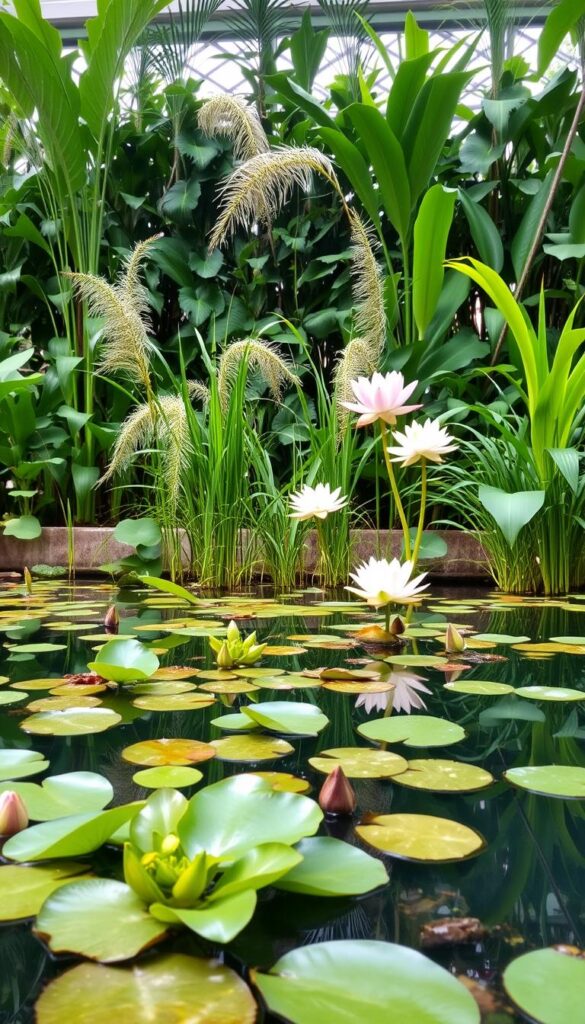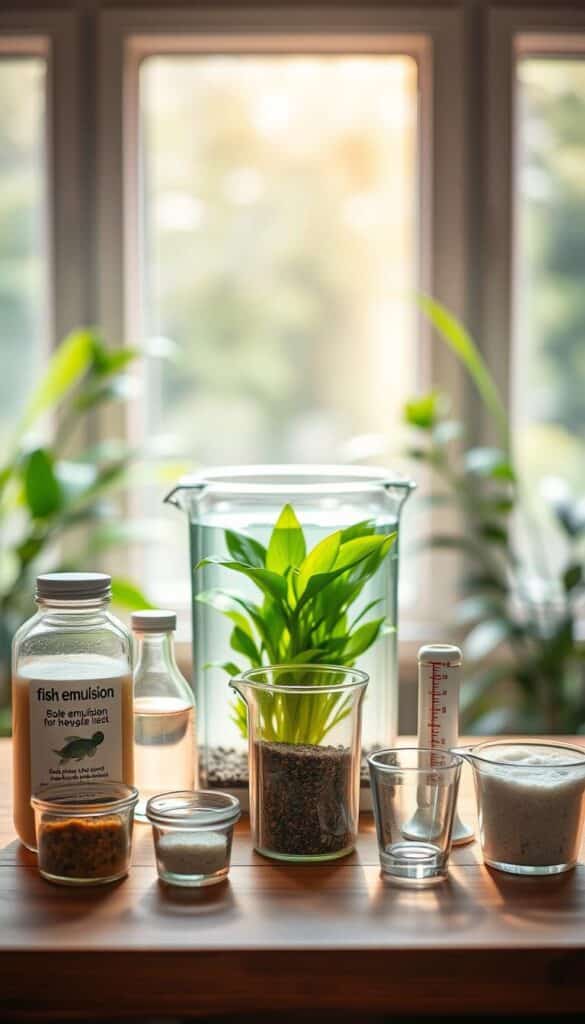Imagine transforming a simple glass vase into a thriving miniature ecosystem. My journey with indoor water gardens began when I stumbled upon the beauty of aquatic plants. It was love at first sight! These fascinating plants not only purify the water but also add a touch of nature to any room.
I chose aquatic plants for my indoor water garden because they offer a unique way to bring life into my home. Using a large glass bowl, I created a space where these plants could flourish. The Madagascar Lace and Tiger Lotus quickly became my favorites—they’re not only stunning but also relatively easy to care for.
I repurposed old glass containers and even tried my hand at some DIY projects to make my garden truly special. Caring for these plants has been a rewarding experience, and I love how they’ve become a part of my daily routine. It’s amazing how something so small can bring so much joy and peace into my home.
In this guide, I’ll share everything I’ve learned about creating and maintaining your own indoor water garden. From selecting the right containers to choosing the perfect plants, I’ll walk you through every step. Whether you’re a seasoned gardener or a curious beginner, this journey is sure to inspire you to create your own indoor oasis.
Choosing the Perfect Container and Substrate
Selecting the right container is the first step in creating a stunning indoor water garden. I prefer using glass bowls or decorative vases because they are non-porous and easy to clean. These containers provide a clear view of the plants and help maintain water clarity.
When it comes to substrate, aquarium gravel and river rocks are excellent choices. They support plant roots and promote beneficial bacterial growth. I recommend adding a layer of Fluval Stratum for nutrient-rich soil that enhances plant growth and water clarity. This setup ensures your plants thrive and your water stays clear.
For a personalized touch, choose gravel and rocks that match your decor. A well-designed container with the right substrate creates a beautiful and functional indoor garden. Start with a glass container, add your chosen substrate, and you’re ready to plant your favorites!
Guide to aquatic plants for indoor water gardens
Creating a thriving indoor water garden starts with choosing the right plants. These plants not only add beauty but also help maintain water clarity and balance. Let’s explore some top choices and where to find them.
Top Plant Choices for My Indoor Oasis
My favorites include the Madagascar Lace and Tiger Lotus, known for their stunning blooms and vibrant foliage. The Brazilian Pennywort adds a delicate touch, while Water Lettuce floats gracefully on the surface. Each plant brings unique characteristics to the garden.
| Plant Name | Growth Pattern | Bloom | Lighting Needs |
|---|---|---|---|
| Madagascar Lace | Slow, delicate | White, star-shaped | Low to medium |
| Tiger Lotus | Fast, spreading | Yellow, sunny | Medium to high |
| Brazilian Pennywort | Medium, trailing | Rare, small | Low to medium |
| Water Lettuce | Fast, floating | None | Medium |
Finding Unique Plants Online and Offline
For quality plants, I recommend Buceplant and Etsy. Local pet stores and eBay are also great options. Mixing species enhances aesthetics and growth, creating a diverse and thriving ecosystem.

Step-by-Step Planting Techniques and Water Tips
Setting up your indoor water garden involves careful planning and attention to detail. Whether you’re a novice or experienced, following these guidelines will help you create a thriving environment for your plants.
Simple Planting Guidelines to Get Started
Start by selecting healthy plants with vibrant colors and robust growth. Gently rinse the roots to remove any excess soil. Place a layer of gravel at the bottom of your glass container to anchor the plants securely. Add a thin layer of aquarium substrate for nutrient-rich soil. Plant the roots firmly, ensuring they’re at the right depth for proper growth.
After planting, slowly pour filtered water into the container to avoid disturbing the substrate. Use recycled aquarium water or dechlorinated water to maintain water clarity and prevent algae buildup. This method ensures a smooth transition for your plants and a clear, healthy environment.
Water Quality, Temperature, and Maintenance Tips
Regular water changes are essential for maintaining a balanced ecosystem. Replace about 10-20% of the water weekly to keep it fresh. Monitor the temperature, keeping it between 72°F to 82°F for optimal plant growth. Avoid sudden temperature fluctuations, as they can stress the plants.
Use a high-quality fertilizer specifically designed for water plants to provide essential nutrients. Avoid over-fertilizing, as this can lead to algae growth. Regularly clean debris and algae to maintain water clarity and ensure your plants thrive.
Lighting Strategies for a Thriving Indoor Water Garden
Lighting is a crucial element in maintaining a healthy and vibrant indoor water garden. Both natural and artificial light sources have their benefits, and understanding their differences can help you create an optimal environment for your plants.
Natural Versus Artificial Lighting Considerations
In my experience, natural light is ideal for promoting healthy plant growth. Placing your indoor water garden near a sunny window provides indirect sunlight, which is gentle on the plants and enhances the visual appeal of the glass container. However, natural light may not always be sufficient, especially during shorter days or in rooms with limited sunlight.
Artificial lighting offers a reliable solution. I recommend using grow lights like the LORDEM Plant Halo, which provides consistent and energy-efficient illumination. These lights are designed to promote robust plant growth without overheating the water. It’s important to maintain a lighting schedule of 12-16 hours daily to mimic natural daylight conditions.
| Light Source | Pros | Cons | Recommended Usage |
|---|---|---|---|
| Natural Light | Promotes healthy growth, enhances visual appeal | Dependent on location and time of day | Place near sunny windows for indirect light |
| Artificial Light | Consistent, energy-efficient, customizable | Can overheat if not monitored | Use grow lights for 12-16 hours daily |
When using artificial lights, it’s essential to monitor the temperature to prevent overheating. Aim for a water temperature between 72°F and 82°F. Proper lighting not only supports plant health but also adds to the beauty of your indoor water garden. Remember, lighting is a long-term commitment, so observe your plants’ responses and adjust your setup as needed.
DIY Fertilizer and Nutrient Management
Maintaining a balanced ecosystem in your indoor water garden can be easy with the right approach to nutrients and fertilizers. I’ve found that a combination of mineral-rich substrates and liquid fertilizers works wonders for plant growth.
For a DIY solution, I recommend using Fluval Stratum as the base substrate. It’s packed with minerals that support healthy root development. Adding a liquid fertilizer like Thrive once a week provides essential nutrients. This combination keeps the water clear and vibrant while promoting lush plant growth.
To make fertilizing simple, I mix 1 teaspoon of Thrive with 1 gallon of water. This solution is gentle and effective, preventing over-fertilization. Regular water changes (about 10-20% weekly) help maintain clarity and prevent sludge buildup.
Monitoring nutrient levels is crucial. Too many nutrients can lead to algae, while too few can stunt growth. By balancing these levels, you ensure your plants thrive without compromising water quality.

Creative Ideas and Decor for My Indoor Oasis
Transforming your indoor water garden into a personalized oasis is all about adding the right decorative touches. I love experimenting with natural elements like driftwood and moss to create a unique ambiance.
Incorporating Driftwood, Moss, and Decorative Elements
Adding driftwood and moss can instantly elevate your garden’s aesthetic. Driftwood adds a rustic charm, while moss creates a lush, green carpet. These elements not only enhance the visual appeal but also contribute to a natural ecosystem.
Personalizing My Space to Reflect My Style
I enjoy mixing complementary colors and textures to match my home’s theme. Whether it’s vibrant plants or decorative stones, every detail reflects my personal style. Even a small snail can add character while helping to keep surfaces clean.
| Decor Element | Benefits | Tips |
|---|---|---|
| Driftwood | Adds rustic charm, provides hiding spots for small creatures | Place near plants for a natural look |
| Moss | Creates a lush carpet, improves water quality | Keep moist and away from direct sunlight |
| Small Snails | Natural cleaning, adds charm | Introduce a few to maintain clarity |
I encourage you to share your creative projects on social media and explore online stores for unique finds. Every element in your design contributes to the garden’s charm, making it a true reflection of your style.
Wrapping Up My Indoor Water Garden Journey
As I reflect on my journey with indoor water gardens, I’m reminded of the joy and serenity they bring to my home. This creative adventure has taught me valuable lessons about balance, care, and the beauty of nature indoors.
Key to a thriving garden is selecting the right container and maintaining water quality. Regular water changes, proper lighting, and a balanced nutrient strategy are essential. Don’t forget to add personal touches like driftwood or moss to make your space unique.
I encourage you to embrace the DIY spirit and experiment with different plants and decor. Share your experiences and successes with others, as gardening is a journey best enjoyed together. Remember, small adjustments like water top-offs and monitoring plant growth can make a big difference.
Thank you for joining me on this adventure. I hope you’ve found inspiration to create your own indoor oasis. Keep exploring and nurturing your garden—it’s a rewarding hobby that brings peace and beauty to your home.
